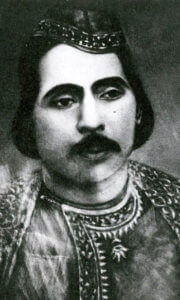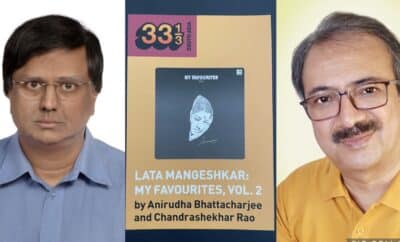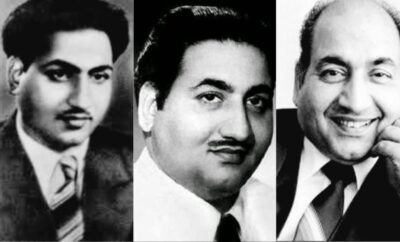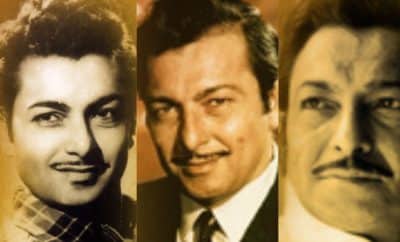Song Sketch
How Many Versions Of This Thumri Do You Know – Mohe Panghat Pe Nandlal
There is a saying in Hindi – Katha Kahe So Kathak, meaning the dance form which comes in a story form is called Kathak. Accompanied by harmonium, tabla, sitar, flute and the euphoric ghungroos, all add to the tales told in a poetic way making the atmosphere pure and divine. The stories told through this dance form are that of Gods, Goddesses or also the historical events of valour and bravery. During the developmental phase of this dance form it got linked to Lord Krishna and his legends. Since then Kathak has been associated very deeply with Krishna. Krishna themes in Kathak have further been classified and thumri is one those classifications. Thumri is semi classical in form and describes a spectrum of episodes of Krishna legends, emotions, expressions and situations. It mainly showcases the legends of Radha and Krishna with Gopis.
Hindi Film music has showcased thumri in various descriptive shades. The listeners are treated to ultra fine semi classical music and mix forms of Kathak dance give a visual, colourful impact on screen. In reality not all the thumris are accompanied by a dance. Hindi films have also often associated thumris with songs rendered by courtesan or are shown in form of a mujra. Hindi films have also adapted some of the traditional thumri bandish as a part of a song or even a full fledged song. One such example is from the iconic Mughal-e-Azam (1960). Prince Salim (Dilip Kumar) falls in love with the court dancer Anarkali (Madhubala) and rebels with his father, the Emperor (Prithviraj Kapoor). His mother, the Queen Jodhabai (Durga Khote) is a Hindu and a devotee of Lord Krishna. There are Janmashtami celebrations at the palace and Anarkali is summoned to present a Krishna legend at the court. She comes up with a beautiful thumri choreographed by Lachchu Maharaj –
https://www.youtube.com/watch?v=H4y8tXUlJjA
Mohe panghat pe nandlal chhed gayo re
Mohe panghat pe
Mori naajuk kalaiyya marod gayo re
Mohe panghat pe hooo
Mohe panghat pe nandlal chhed gayo re
Mohe panghat pe
Kankari mohe maari, gagariya phod daari
Haay gagariya phod daari
Mori saree anaadi bhigoy gayo re
Mohe panghat pe nandlal chhed gayo re
Mohe panghat pe
Naino se jaadu kiya, jiyra moh liya
Haay jiyra moh liya ho
Mora ghunghta najariyo se tod gayo re
Mohe panghat pe nandlal chhed gayo re
Mohe panghat pe, aji haan
Mohe panghat pe
Based on Raag Gara which is a late morning or early afternoon Raag, the song is credited to Shakeel Badayuni and Naushad. It brings out not only the transparent beauty of Madhubala but also faultless singing by Lata Mangeshkar. But not many know that the song is not an original one (including the music and lyrics). It is said that this thumri was written by Raghunath Brahmbhatt ‘Raskavi’ from Gujrat for a play from 1920s called Chhatra Vijay. But there is also a controversy of this song being a traditional bandish for thumri.
It is thus mentioned in the book Encyclopedia Of Hindi Cinema – In Hindustani films, the tabla and the harmonium were used to provide the effects for chase scenes and then to play the sad and the happy melodies acquired from classical ragas and folk songs. At times they were played with words and the bandish, or the phrase of the raga. For instance Kalka Bindadin used to sing Mohe Panghat Pe Nandlal Chhed Gayo Re in Wajid Ali Shah’s court.
It further says – Amongst the great exponents of the dance form of Kathak, Lachchu Mharaj also choreographed the classical dance numbers in landmark films like Pakeezah and Mughal-e-Azam. Lachchu Maharaj was born Baijnath Prasad in Lucknow, Uttar Pradesh. His family – father Kalka Prasad, uncle Bindadin Maharaj and brother Shambhu Maharaj – the leading practitioners of Luncknow gharana or the school of Kathak. Lachchu Maharaj received traning from his uncle Bindadin Maharaj.

Bindadin Maharaj – Lucknow Gharana
But there are recordings of these thumris rendered by Indubala in 1930 and Ustad Azmat Hussain Khan in 1932.
Indubala version –
Lyrics – Indubala version –
Mohe panghat par Nandlal chhed liyo re ae
Mori naajuk kalaiyaa aa maror diyo re ae
ae ae ae
Nipat jhapat mori, sar ki gagariya phodi
Aur churiyaan kasai diyo re
Mohe panghat par Nandlal chhed liyo re
Mohe panghat par Nandlal
Ustad Azmat Hussain Khan version –
The lyrics of this version are not very clear but they begin with Panghatwa pe Nandlal chhed layi re. Apart from these versions if you come across more versions of this traditional thumri please contribute and share in the comments.




dilipapte25
July 4, 2017 at 2:41 pm
Yes, there was a lot written , about this on the origin of the song being by Raghunath Brahmbhatt ‘Raskavi’ from Gujrat . I remember reading somewhere that Naushad also acknowledged it and finally, when the full colour version of the film Mughal-e-Azam was released- Raskavi Raghunath Bramhabhat was given credit for the song. Will provide the DNA link after my comment. You have attributed Thumris to telling stories of Lord Krishna- which is largely true, but I think 2 of those ‘Bandish’ with Lord Ram too fall in that category- 1 ] Thumak chalat Ramchandra, bajat painjaniya- which has been sung by D V Paluskar , Lata Mangeshkar and many others , 2 ] Payoji Maine Ramratan dhan payo- which also has been rendered by many great singers. Here is the link for the Raskavi Brrahmabhat being credited for the song==http://www.dnaindia.com/mumbai/report-mughal-e-azam-songwriter-gets-his-due-10443
Deepa
July 5, 2017 at 3:17 pm
Thank you for commenting 🙂 I’ve updated the article with some more information 🙂
Jamal Kochangadi
July 26, 2019 at 10:26 pm
USt
Rajeshwarichauhan55555@gmail.com
January 8, 2023 at 11:26 am
Thank u for this article. Ras kavi Raghunath Brahmhatt’s four lines I came across after famous first stanza are…..”mori choli ke tang bandh tod gayo re. Kankariya mohe mari, gagariya phor dali ..Shyam sunder chunariya bhinjay gayori. Mohe nainan ke sen mein samjay gayo ri.”?